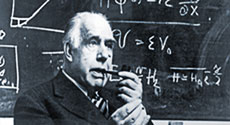Niels Bohr Lecture by Desika Narayanan, University of Florida
A Universe of Dusty Galaxies
Abstract: The most incredible bursts of star formation in galaxies occur during the Universe's infancy, and are enshrouded in cocoons of giant clouds of obscuring dust.
Understanding the nature of this dust-obscured star formation over cosmic history is a decades-old problem, now being revolutionized observationally by the Atacama Large Millimeter Array and James Webb Space Telescope facilities, which can peer to the birth of some of the first massive galaxies in the Universe.
I will describe the history of our understanding of dust-obscured star formation in the early Universe, as well as the current state-of-the-art of massive supercomputer simulations of cosmological galaxy evolution that attempt to build a concordance model of the evolution of massive starbursting galaxies across cosmic time.
Bio:
Desika Narayanan is an Associate Professor of Astronomy at the University of Florida, and an International Associate of the Cosmic Dawn Centre at NBI/DTU. His research focuses on the astrophysical theory of galaxy formation, and in particular, the complex interplay between star formation, galaxy evolution, and the physics of the interstellar medium (the gas that fills the space between the stars).
He runs large scale numerical simulations of cosmological galaxy evolution, and develops techniques both at the intersection of theory and observations, as well as traditional computation and AI in order to forward his research.
He began his career at the University of Florida (undergraduate), and earned his PhD at the University of Arizona in 2007. Following postdoctoral fellowships at Harvard and again at the University of Arizona, he spent 3 years on the faculty at Haverford College, before returning to the University of Florida in 2017.
Outside of Astronomy, Desika is an avid surfer, snowboarder, and (roller) hockey player.
 Niels Bohr Lectures er en engelsk-sproget foredragsrække på Niels Bohr Institutet med kendte forskere fra hele verden.
Niels Bohr Lectures er en engelsk-sproget foredragsrække på Niels Bohr Institutet med kendte forskere fra hele verden.
Foredragene holdes cirka 10 gange om året og er offentlige. De er for studerende og ansatte ved Niels Bohr Institutet samt andre med interesse for at høre om videnskabelig forskning i verdensklasse. Foredragene holdes på et ikke-teknisk niveau, hvor de kan forstås af alle med en baggrundsviden, der svarer til de første år på fysikstudiet.
Tidspunkt og sted: Hvis intet andet er anført, finder foredragene sted kl. 15.15 i Margrethe Bohr Salen, Niels Bohr Bygningen, 2200 København N. Kaffe og kage serveres en halv time inden foredraget starter.
The lectures are public and held about 10 times a year. The lectures are for students and staff at the Niels Bohr Institute and others interested in worldwide scientific research. The lectures are held on a non-technical level where they can be understood by anyone with a background similar to the first year of physics study.
Time and place: Unless otherwise specified, the lectures take place at. 15.15 in Margrethe Bohr Salen, Niels Bohr Bygningen, 2200 Copenhagen N. Coffee and cake will be served half an hour before the lecture starts.
